This article has multiple issues. Please help improve it or discuss these issues on the talk page. (Learn how and when to remove these messages)
|
| Part of a series on the | ||||||||||||||||
| History of China | ||||||||||||||||
|---|---|---|---|---|---|---|---|---|---|---|---|---|---|---|---|---|
Prehistoric
|
||||||||||||||||
Ancient
|
||||||||||||||||
Imperial
|
||||||||||||||||
Modern
|
||||||||||||||||
| Related articles | ||||||||||||||||
The political systems of Imperial China can be divided into a state administrative body, provincial administrations, and a system for official selection. The three notable tendencies in the history of Chinese politics includes, the convergence of unity, the capital priority of absolute monarchy, and the standardization of official selection. Moreover, there were early supervisory systems that were originated by local factions, as well as other political systems worthy of mention.
Fundamental System: Autocratic Monarchy
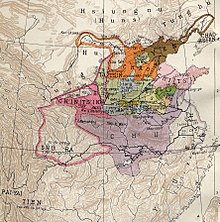
Principles and Foundation
During the Warring States period, Shang Yang from the state of Qin would enact political reforms into practice. The ancient Chinese text Han Feizi proposed the establishment of the first all-encompassing autocratic monarchy for the future of the state. The imperial system would eventually be constituted by the time of the establishment of the Qin, which would introduce the system of Three Lords and Nine Ministers as well as fostering the system of prefectures and counties. Units of measurements, currency, and writing would be standardized, books and scholars of the previous regime burned and buried to keep ideological integrity, and officials were to act as faculties of the law.
Consolidation and Reinforcement

In resolute action to settle domestic concerns, Western Han conducted conclusive capital punishments, issued the Decree of Mercy and the Law of Supplementary Benefits, denounced the Hundred Schools of Thought, and only extolled Confucianism. By instituting the system of three provinces and six ministries, the feudal bureaucracy completed and achieved a rigorous system that diminished the prime minister's power and reinforced imperial power. Complementary to this governing body, establishment and improvement of the Imperial Civil Examination enhanced the availability of invigorated government officials which in turn provided a recurrent administration. Regulation of military power requisitioned the removal of total military authority from senior generals and local commanders. This, in turn, permitted sanctioning of three government officials to command the imperial army of which were mediated internally via privy council. Within the framework of organized executive power; the administration, the military, the financial powers of the chief ministers, the privy Councillors, and the three Secretaries partitioned and absorbed the authorities of the prime minister, respectively. Regulation of financial power was acquired by arranging consignments on appropriate levels of operations to coordinate local finances. Finally, standardization of judicial powers was executed via dispatching of civil officials to serve as local judiciaries. These means and measures concentrated the sovereignty of the head of state; surmounting military, administrative, financial, and judicial authority from all levels of governance, this subsequently vanquished the foundation of feudal-vassal separation.
Further Development and Final Shape
In the central government, the executive system of central officials was improved during Yuan dynasty. It established the Xuanzheng Yua (the Bureau of Buddhist and Tibetan Affairs) to direct religious affairs and to govern the region of Tibet. At the local level, the provincial system was practiced. At the beginning of the Ming dynasty, the prime minister was abolished, and the power was divided into six departments. The local government implemented the division of power among the three functioning departments. The Qing dynasty followed the system of the Ming dynasty, set up more military offices, put up literary prisons, thus strengthened the centralisation of authoritarianism.

Central political system
Three Lords and Nine Ministers system
Main article: Three Lords and Nine MinistersThe three lords and nine ministers system was a central administrative system adopted in ancient China that was officially instituted in Qin dynasty and later developed in Han dynasty.
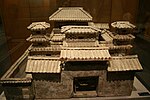
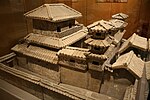 A pottery model of a palace from a Han dynasty tomb; the entrances to the emperor's imperial palaces were strictly guarded by the Commandant of Guards, and if it was found that a commoner, official, or noble entered without explicit permission via a tally system, they were liable for execution.
A pottery model of a palace from a Han dynasty tomb; the entrances to the emperor's imperial palaces were strictly guarded by the Commandant of Guards, and if it was found that a commoner, official, or noble entered without explicit permission via a tally system, they were liable for execution.
Three Lords referred to three highest rank officials in the imperial government, namely:
- the Chancellor
- the Imperial Secretary
- the Grand Commandant
Nine Ministers comprised all the ministers of importance in the central government. They were:
- the Minister of Ceremonies
- the Supervisor of Attendants
- the Commandant of Guards
- the Minister of Coachmen
- the Commandant of Justice
- the Grand Herald
- the Director of the Imperial Clan
- the Grand Minister of Agriculture
- the Small Treasurer
Three departments and six ministries system
Main article: Three Departments and Six MinistriesThe three lords and nine ministers system was replaced by the system of three provinces and six ministries by Emperor Wen of the Sui dynasty. The three departments were Shangshu, Zhongshu and Menxia. The central committee was responsible for drafting and issuing imperial edicts; Subordinate provinces shall be responsible for the examination and verification of administrative decrees; Shangshu was responsible for carrying out important state decrees, and the heads of the three provinces were all prime ministers. The six ministries were officials, households, rites, soldiers, punishments, and workers. The three provinces and six ministries had both divisions of labor and cooperation, and they supervised and contained each other, thus forming a strict and complete system of the feudal bureaucracy, effectively improving administrative efficiency and strengthening the ruling power of the central government. The separation of the three powers weakens the power of the prime minister and strengthens the imperial power. The officially adopted systems of Song, Yuan, Ming, and Qing dynasties all changed a little on this basis.
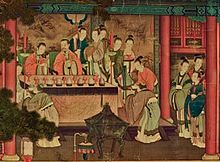
| Emperor (皇帝, huángdì) | |||||||||||||||||||||||||||||||||||||||||||||||
| Chancellery (t 門下省, s 门下省, Ménxiàshěng) | Department of State Affairs (t 尚書省, s 尚书省, Shàngshūshěng) | Secretariat (t 中書省, s 中书省, Zhōngshūshěng) | |||||||||||||||||||||||||||||||||||||||||||||
| Ministry of Personnel (吏部, Lìbù) | Ministry of Revenue (t 戶部, s 户部, Hùbù) | Ministry of Rites (t 禮部, s 礼部, Lǐbù) | Ministry of War (兵部, Bīngbù) | Ministry of Justice (刑部, Xíngbù) | Ministry of Works (工部, Gōngbù) | ||||||||||||||||||||||||||||||||||||||||||

Prime minister system

Qin established the system of three lords and nine ministers in the central government. Emperor Wu of the Western Han dynasty reformed the official system implemented the internal and external dynasties system and weakened the power of the prime minister. Emperor Guangwu of the Eastern Han dynasty expanded the power of the Shangshu department. Sui and Tang dynasties established the system of three provinces and six departments, dividing the power of the prime minister into three and containing each other, which reflected the strengthening of the imperial power. In the northern song dynasty, under the chancellors, the chief ministers were appointed as deputy ministers to divide the administrative power of the chancellors. There were privy secretaries to divide the military power and three divisions to divide the financial power. The Yuan dynasty set up a Zhongshu province, with prime ministers on the right and left, exercising the functions and powers of prime ministers. The Ming dynasty abolished the prime minister and divided the power into six parts. Emperor Yongle set up a cabinet and implemented "draft vote." The military offices were set up in the Qing dynasty, and the remnants of the prime minister system disappeared, reflecting that the imperial power had reached its peak. From the changes, we can see that the emperor divided and weakened the power of the prime minister, gradually concentrated all kinds of power in his own hands, and thus effectively implemented the autocratic monarchy. Notable prime ministers include Prime Minister Zhu of Shu, Prime Minister Xiao of Western Han and Prime Minister Wang of Song.

Local political systems
Enfeoffment system
To consolidate the power of slave owners, the rulers of the Western Zhou dynasty implemented the system of enfeoff vassals politically, which enabled the Zhou dynasty to consolidate its rule and expand its territory. In the spring and autumn period, it gradually collapsed and was replaced by the system of prefectures and counties, which remained in some later dynasties.
Prefecture and county system
During the Spring and Autumn period and the Warring States period, the Qin dynasty was carried out nationwide, thus replacing the feudal system nationwide, greatly weakening the independence of local authorities and strengthening the centralization of power. This was an epoch-making reform in China's local administrative system. The prefecture and county system was used for a long time in ancient China, with a very far-reaching influence.
Province system
At the beginning of the Western Han dynasty, the system of prefectures and counties was implemented in local areas, and at the same time, the system of enfeoffment was established. Counties and countries were parallel to each other, which was not conducive to the unified management of the country, with the risk of division. The Yuan dynasty was a feudal country with a vast territory at that time. Its establishment consolidated the unification of the country and ensured the centralization of power in the system. The provincial system of the Yuan dynasty had a far-reaching influence on the political system of later generations. Since then, the provincial system has become the local administrative organ of China, which was followed in the Ming and Qing dynasties and has been retained until today.
| Administrative unit | Administrator title | Appointment | Authority |
|---|---|---|---|
| Province (州 zhou) | Governor (牧 mu) | Central | Executive |
| Inspector (刺史 cishi) | Central | No direct authority | |
| Commandery (郡 jun) | Grand administrator (太守 taishou) | Central | Executive |
| Kingdom (王國 wangguo) | Chancellor (相 xiang) | Central | Executive |
| King (王 wang) | Hereditary | Symbolic | |
| County (縣 xian) | Prefect (令 ling) Chief (長 zhang) |
Central | Executive |
Monk system
In the Ming dynasty, Tibet practiced the system of monks and officials. Because the Tibetan people believed in Tibetan Buddhism, the Ming government used religion to rule the Tibetan people which was later called the 'monk system'.
Eight banners system


The eight banners system was in the late Ming dynasty when Nuzhen rulers Nurhaci to create a system of eight banners system according to the military organization form the Jurchen establishment, controlled by the aristocrat, with military conquering three functions, administrative management, organize production, is a soldier and unity of social organization, is a military organization and administrative management system, promote the development of the Nuzhen society. The eight banners army played an important role in unifying China in the Qing dynasty. However, with the invasion of western capitalism , the corruption of the eight banners army itself and the gradual decline of its combat effectiveness, the Hunan army and Huai army, which rose up in the process of suppressing the Taiping Heavenly Kingdom, had a great impact on it.
Bureaucratisation of Local Officers
During the reign of the Ming dynasty, in successive congruity with the Yuan dynasty, installed and enforced a provincial system in the southwest region, where residential officials received sponsorship from the central government. These residential officials, held by local factions, exercised their administration within their jurisdiction until the fall of the Great Ming.
Official selection system
Evolution of Official Selection
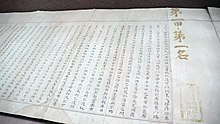

The standard of Official Selection by familial history gradually developed to emphasize talent instead. This method would eventually progress to form the standard of public examinations, to which this mechanism of cultivating talent would be institutionalized, making examinations a notoriously rigorous process to accomplish.
| Degree | Ranks | Exam | Times held |
|---|---|---|---|
| Child student (Tongsheng) | County/Prefectural | Annual (February/April) | |
| Student member (Shengyuan) | Granary student (1st class) Expanded student (2nd class) Attached student (3rd class) |
College | Triennial (twice) |
| Recommended man (Juren) | Top escorted examinee (1st rank) | Provincial | Triennial |
| Tribute scholar (Gongshi) | Top conference examinee (1st rank) | Metropolitan | Triennial |
| Advanced scholar (Jinshi) | Top thesis author (1st rank) Eyes positioned alongside (2nd rank) Flower snatcher (3rd rank) |
Palace | Triennial |
Imperial supervision systems

Qin dynasty
The central government set up the imperial historian, whereas the local government set up the imperial supervisor.
Western Han dynasty
Emperor Wudi of the Han dynasty set 13 prefectures as the supervision area, and set the provincial history department for supervision.
Eastern Han dynasty
The supervision power of the provincial governor was further strengthened, and the local administrative power and military power were gradually increased. At the end of the Eastern Han dynasty, the provincial governor evolved into the local highest military and political officer.

Northern Song dynasty
There was a general court to supervise the prefectures, which could report directly to the emperor.
Ming dynasty
The local government set up the department of criminal investigation to administer local supervision and justice. In addition, the factory also set up a spying agency to monitor officials and civilians at all levels.
Political systems created by local factions
Uniform land system, rent modulation, government military system, Fan-Han divide and rule system, fierce peace and restraint, provincial system, and the eight flag system are critical systems created by local factions of noteworthy historical mention.
Other critical political systems in ancient China
Eclectical system
During the closing era of archaic society, the selective appointment of affiliated alliance leaders was conducted within the circle of noble families. This was not only reflective of antiquating public participation in politics, but also a sign of archaic society's vestiges.
Hereditary system
A hereditary system with its distinctive privatization embodied the significant progress of society.
Patriarchal systems
Since the Western Zhou dynasty, the patriarchal clan system was a system in which the inheritance relationship and the title were determined by blood relationship and marital status. The patriarchal clan system and privilege system formed by the patriarchal system had a far-reaching influence on later generations.
Gentry system
The gentry was developed from influential landlords and belonged to the most prestigious stratum of the landlord class. The gentry system was formed during the Wei and Jin dynastic era. This system selected officials in accordance to the level of their familial backgrounds, though it was often notably plagued by corruption.
See also
References
- The Cambridge history of ancient China : from the origins of civilization to 221 B.C. Loewe, Michael., Shaughnessy, Edward L., 1952-. Cambridge, UK: Cambridge University Press. 1999. ISBN 0521470307. OCLC 37361770.
{{cite book}}: CS1 maint: others (link) - Shang, Yang, -338 B.C.; 商鞅, -338 B.C. (1993). Shang jun shu quan yi. Zhang, Jue., 张觉. (Di 1 ban ed.). Guiyang: Guizhou ren min chu ban she. ISBN 7221029148. OCLC 45812779.
{{cite book}}: CS1 maint: multiple names: authors list (link) CS1 maint: numeric names: authors list (link) - Dao companion to the philosophy of Han Fei. Goldin, Paul Rakita, 1972-. Dordrecht: Springer. 2013. ISBN 9789400743182. OCLC 811051672.
{{cite book}}: CS1 maint: others (link) - Sima, Qian, approximately 145 B.C.-approximately 86 B.C. (1993). Records of the Grand Historian. Qin dynasty. Watson, Burton, 1925-2017. Hong Kong: Research Centre for Translation, Chinese University of Hong Kong. ISBN 0231081693. OCLC 28322132.
{{cite book}}: CS1 maint: multiple names: authors list (link) CS1 maint: numeric names: authors list (link) - Skocpol, Theda. (1979). States and social revolutions : a comparative analysis of France, Russia, and China. Cambridge: Cambridge University Press. ISBN 052122439X. OCLC 4135856.
- Qiu, Xigui; 裘錫圭. (2000). Chinese writing. Mattos, Gilbert Louis, 1939-, Norman, Jerry, 1936-2012,, Qiu, Xigui,, 裘錫圭. Berkeley, California. ISBN 1557290717. OCLC 43936866.
{{cite book}}: CS1 maint: location missing publisher (link) - Sommer, Matthew Harvey, 1961- (2015-09-15). Polyandry and wife-selling in Qing Dynasty China : survival strategies and judicial interventions. Oakland, California. ISBN 9780520962194. OCLC 913086388.
{{cite book}}: CS1 maint: location missing publisher (link) CS1 maint: multiple names: authors list (link) CS1 maint: numeric names: authors list (link) - Bellezza, John Vincent. (2014). The dawn of Tibet : the ancient civilization on the roof of the world. Lanham, MD. ISBN 9781442234611. OCLC 870098261.
{{cite book}}: CS1 maint: location missing publisher (link) - Zhongguo Qing dai zheng zhi shi. Xu, Kai., 徐凯. (Di 1 ban ed.). Beijing: Ren min chu ban she. 1994. ISBN 7010017573. OCLC 32676386.
{{cite book}}: CS1 maint: others (link) - Zhou, Haiwen (April 2012). "Internal Rebellions and External Threats: A Model of Government Organizational Forms in Ancient China" (PDF). Southern Economic Journal. 78 (4): 1120–1141. doi:10.4284/0038-4038-78.4.1120. ISSN 0038-4038.
- Ch'ü (1972), 68–69.
- ^ Li, Konghuai (李孔懷) (2007). Zhongguo gu dai xing zheng zhi du shi (Xianggang di 1 ban ed.). Xianggang: San lian shu dian (Xianggang) you xian gong si. ISBN 9789620426544. OCLC 166413670.
- Higham, Charles (2004). Encyclopedia of ancient Asian civilizations. New York, NY: Facts On File. ISBN 0816046409. OCLC 51978070.
- Lü, Simian (吕思勉) (2008). Zhongguo tong shi : cha tu zhen cang ben = the history of China (1st ed.). Beijing: New World Press. ISBN 9787802285699. OCLC 232550968.
- Zeng, Jifen, 1852-1942. (1993). Testimony of a Confucian woman: the autobiography of Mrs. Nie Zeng Jifen, 1852-1942. Kennedy, Thomas L., 1930-2015., Kennedy, Micki. Athens, Ga.: University of Georgia Press. ISBN 0820315095. OCLC 26129546.
{{cite book}}: CS1 maint: multiple names: authors list (link) CS1 maint: numeric names: authors list (link) - Cotterell, Arthur. (2006). Leadership lessons from the ancient world : how learning from the past can win you the future. Lowe, Roger, 1954-, Shaw, Ian, 1944-. Chichester, England: John Wiley. ISBN 9781119208457. OCLC 70863722.
- Yuan, Naiying.; 袁乃瑛. (2004). Selections from classical Chinese historical texts : glossaries, analyses, exercises. Tang, Hai-tao., Geiss, James., Sima, Qian, approximately 145 B.C.-approximately 86 B.C., Ban, Gu, 32-92., Fan, Ye, 398-445., Chen, Shou, 233-297. Princeton, N.J. ISBN 0691118345. OCLC 57523905.
{{cite book}}: CS1 maint: location missing publisher (link) - ^ The Cambridge history of China. Twitchett, Denis Crispin, 1925-2006., Fairbank, John King, 1907-1991. Cambridge : Cambridge University Press. 1996. ISBN 9780521243278. OCLC 2424772.
{{cite book}}: CS1 maint: others (link) - Janecek, P.; Vorburger, J.; Campana, A.; Stamm, O. (1975). "". Geburtshilfe und Frauenheilkunde. 35 (7): 511–517. ISSN 0016-5751. PMID 2513.
- Xuan, Xu (2013). "Introduction". Social Sciences in China. 34 (1): 122–123. doi:10.1080/02529203.2013.760720. ISSN 0252-9203. S2CID 219695026.
- Yu-ch'uan, Wang (1949). "An Outline of The Central Government of The Former Han Dynasty". Harvard Journal of Asiatic Studies. 12 (1/2): 134–187. doi:10.2307/2718206. JSTOR 2718206.
- Xie, Chongguang.; 谢重光. (2009). Zhong gu fo jiao seng guan zhi du he she hui sheng huo (Di 1 ban ed.). Beijing: Shang wu yin shu guan. ISBN 9787100059084. OCLC 433512892.
- Gyllenbok, Jan, 1963- (2018-04-12). Encyclopaedia of historical metrology, weights, and measures. Volume 3. Cham. ISBN 9783319667126. OCLC 1031847554.
{{cite book}}: CS1 maint: location missing publisher (link) CS1 maint: multiple names: authors list (link) CS1 maint: numeric names: authors list (link) - "Conflicting counsels to confuse the age : a documentary study of political economy in Qing China, 1644-1840". sydney.primo.exlibrisgroup.com. Retrieved 2019-06-07.
- "Mongolian rule in China : local administration in the Yuan Dynasty". sydney.primo.exlibrisgroup.com. Retrieved 2019-06-07.
- Liu, Haifeng (2006). "Rehabilitation of the imperial examination system". Frontiers of Education in China. 1 (2): 300–315. doi:10.1007/s11516-006-0009-0. ISSN 1673-341X. S2CID 195309053.
- "宋元科舉三錄 / 徐乃昌校栞.; Song Yuan ke ju san lu". sydney.primo.exlibrisgroup.com. Retrieved 2019-06-07.
- ^ Zhongguo gu dai jian cha zhi du fa zhan shi. JIa, Yuying., 贾玉英. (Di 1 ban ed.). Beijing: Ren min chu ban she. 2004. ISBN 7010042411. OCLC 57198607.
{{cite book}}: CS1 maint: others (link) - Roberts, J. M. (John Morris), 1928-2003. (1997). A short history of the world. New York. ISBN 019511504X. OCLC 35990297.
{{cite book}}: CS1 maint: location missing publisher (link) CS1 maint: multiple names: authors list (link) CS1 maint: numeric names: authors list (link) - Su, Li, 1955- (2018-08-07). The constitution of ancient China. Zhang, Yongle,, Bell, Daniel (Daniel A.), 1964-, Ryden, Edmund. Princeton, New Jersey. ISBN 9781400889778. OCLC 1037945918.
{{cite book}}: CS1 maint: location missing publisher (link) CS1 maint: multiple names: authors list (link) CS1 maint: numeric names: authors list (link) - Pines, Yuri. (2012). The everlasting empire : the political culture of ancient China and its imperial legacy. Princeton, N.J.: Princeton University Press. ISBN 9781400842278. OCLC 782923553.
- The Ch'in and Han empires, 221 B.C. - A.D. 220. Twitchett, Denis Crispin, 1925-2006,, Loewe, Michael. Cambridge : Cambridge University Press. 1986. ISBN 9781139054737. OCLC 317592775.
{{cite book}}: CS1 maint: others (link) - "Emperor and ancestor : state and lineage in South China". sydney.primo.exlibrisgroup.com. Retrieved 2019-06-07.
- Zhang, Qizhi (2015-04-15). An introduction to Chinese history and culture. Heidelberg. ISBN 9783662464823. OCLC 907676443.
{{cite book}}: CS1 maint: location missing publisher (link) - Tackett, Nicolas (2014). The destruction of the medieval Chinese aristocracy. Cambridge, Massachusetts: Harvard University Asia Center.
See also
| Articles on specific dynasties | |||||||||||||||||||||||||||||||||||||||||||||||||||||||||||||||||||||||||||||||||||||||||||||||||||||||||||||||||||||||||||||||||||||||||||||||||||||||||||||||||||||||||||||||||||||||||||||||||||||||||||||||||||||||||||||||||||||||||||||||||
|---|---|---|---|---|---|---|---|---|---|---|---|---|---|---|---|---|---|---|---|---|---|---|---|---|---|---|---|---|---|---|---|---|---|---|---|---|---|---|---|---|---|---|---|---|---|---|---|---|---|---|---|---|---|---|---|---|---|---|---|---|---|---|---|---|---|---|---|---|---|---|---|---|---|---|---|---|---|---|---|---|---|---|---|---|---|---|---|---|---|---|---|---|---|---|---|---|---|---|---|---|---|---|---|---|---|---|---|---|---|---|---|---|---|---|---|---|---|---|---|---|---|---|---|---|---|---|---|---|---|---|---|---|---|---|---|---|---|---|---|---|---|---|---|---|---|---|---|---|---|---|---|---|---|---|---|---|---|---|---|---|---|---|---|---|---|---|---|---|---|---|---|---|---|---|---|---|---|---|---|---|---|---|---|---|---|---|---|---|---|---|---|---|---|---|---|---|---|---|---|---|---|---|---|---|---|---|---|---|---|---|---|---|---|---|---|---|---|---|---|---|---|---|---|---|---|---|---|---|---|---|---|---|---|---|---|---|---|---|---|---|---|
| |||||||||||||||||||||||||||||||||||||||||||||||||||||||||||||||||||||||||||||||||||||||||||||||||||||||||||||||||||||||||||||||||||||||||||||||||||||||||||||||||||||||||||||||||||||||||||||||||||||||||||||||||||||||||||||||||||||||||||||||||

